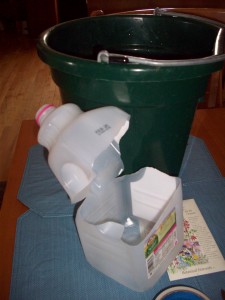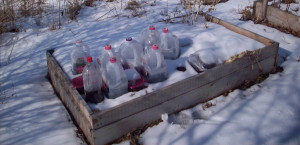Day 14: Winter Sowing for Your Vegetable Garden

One of the most popular articles ever written for Northern Gardener was on winter-sowing perennials. Winter sowing involves sowing seeds outdoors in mini-greenhouses, made of milk jugs, deli containers and other sealed plastic containers. The seeds are planted in damp soil, then the containers are set outside. Natures thawing and freezing cycles help crack open the seeds, and as the temperature warms, the seeds will sprout and grow.
There has been a lot written about winter sowing, so for how-to instructions check out this article by Terry Yockey or this one from the My Northern Garden blog. Or Eric Johnson’s article on winter sowing tomatoes. Of this very helpful list of which vegetables, flowers and herbs can be winter sown. Terry also put up a video that’s worth checking out for visual instructions. Gardeners who want to grow perennials from seed using the method can set out their winter sowing containers as early as January, but the process for starting vegetable seeds is timed differently.
Generally, you can set out winter sowing containers with vegetable seeds about the same time you would start the seeds indoors under lights. So, for chard, kale and other hardy greens, set the winter sowing containers outside about mid-March. Herbs also germinate well in containers, especially some of the hardier ones, such as parsley, oregano and thyme. Early April is a good time to set out containers with tomato seeds. The seeds will germinate when the soil and air temperatures are warm enough inside the container. Place the container in a sunny spot near the house for best results. If the weather gets really nasty (say sudden temperatures in the teens or lower), you may want to throw a blanket over them at night.

As the seedlings grow and the outdoor temperatures warm, you will want to increase the size of the air holes in the containers and eventually remove the covers entirely. As the seedlings mature, you can transplant them into the garden — June 1 is a good time for tomatoes, earlier for greens.
So what is the advantage of winter sowing over sowing seeds indoors? First, you don’t have to buy and set up lights indoors. Most homes do not have enough sunlight to start seeds indoors without grow lights, so that is a necessary investment. Second, the care is somewhat easier — set them outside, let nature work. Once the seeds sprout, you will have to water them as the get bigger, of course, but you won’t have to go through hardening them off. My experience is that winter sown vegetables start out a bit slower and wimpier than those started indoors under lights, but they soon catch up in the garden.
Have you tried winter sowing for your vegetables? How did it work?
-Mary Lahr Schier
Follow Notes from Northern Gardener throughout January as we offer our series on 31 Days to a Great Northern Vegetable Garden. Tomorrow: When to Plant What in Your Vegetable Garden.
Ready to grow? Save a spot in an upcoming webinar or workshop!

HI, This is my first attempt at winter sowing. I’d like a list/chart of annuals, perennials and flowering shady and vegetables areas plants and times to plant them. I’m also wondering, if asparagus will grow in a planter box! What are the guidelines for successful growing. I don’t want to feed Peter Rabbit!
Kathryn — Here’s a post from a Twin Cities garden blogger about winter sowing. It includes a chart you can use to decide which seeds to sow outside. Good luck! https://ginghamgardens.com/winter-sowing-yes-you-can-garden-in-winter/
Thank you, Mary.
I’ve been saving milk jugs to try this again! I had luck years ago with watermelons and tomatoes – until my at the time two year old decided to play in the dirt 🙂
I appreciate the information! Thanks!